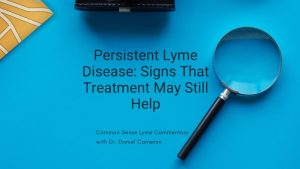Call for your appointment today 914-666-4665 | Mt. Kisco, New York

 A read of the International Lyme and Associated Diseases Society (ILADS) 2014 evidence based guidelines says otherwise. The ILADS guidelines focus on the risk of poor outcomes such as chronic neurologic Lyme disease, Lyme encephalopathy, and post-Lyme disease syndrome.
A read of the International Lyme and Associated Diseases Society (ILADS) 2014 evidence based guidelines says otherwise. The ILADS guidelines focus on the risk of poor outcomes such as chronic neurologic Lyme disease, Lyme encephalopathy, and post-Lyme disease syndrome.
The ILADS guidelines highlight the poor evidence using the Institute of Medicine’s recommended evidence grading system. The guideline placed a high value on the ability of the clinician to exercise clinical judgment. According to the ILADS panel, guidelines should not constrain the treating practitioner from exercising clinical judgment in the absence of strong and compelling evidence to the contrary.
“Treatment regimens may employ either a sole agent or combinations of antibiotics, depending on which mechanisms of persistence the clinician is attempting to thwart. The delivery method – oral, Intravous (IV), intramuscular (IM) – is dependent on the agents selected, disease severity and patient preferences,” according to ILADS guidelines.
“It is reasonable to start with dosages examined in clinical trials, but clinicians may decide to adjust dosages in individual patients with the goal of improving outcomes by achieving adequate drug levels in all infected tissues.”
The ILADS guidelines discuss a range of antibiotics including oral amoxicillin, phenoxymethylpenicillin, tetracycline and macrolide classes, metronidazole; IV Ceftriaxone, cefotaxime, and penicillin; and IM benzathine penicillin. The guidelines recommend that clinicians advise patients to take probiotics daily while on antibiotic therapy. Probiotics reduce the risk of C. difficile colitis and antibiotic-associated diarrhea. Recommendation 3C advises that clinicians “re-assess patients immediately following the completion of the initial course of retreatment to evaluate the effectiveness of retreatment and the need for therapeutic adjustments.”
“If the initial course of antibiotic retreatment does not produce a complete response, clinicians should consider various options. Patients who had an incomplete response with one agent may be responsive to another; thus, switching agents may prove successful. Alternatively, combination therapy may be appropriate in select patients. Examples include those with known or suspected co-infections and patients who had incomplete responses to single-agent therapy.”
“When it comes to Lyme disease, one size does not fit all,” says Daniel Cameron, MD, an Internist and Epidemiologist.
References
Infectious Disease Society of America (IDSA) Guidelines
https://www.ncbi.nlm.nih.gov/pubmed/17029130
International Lyme and Associated Diseases Society (ILADS) Guidelines



